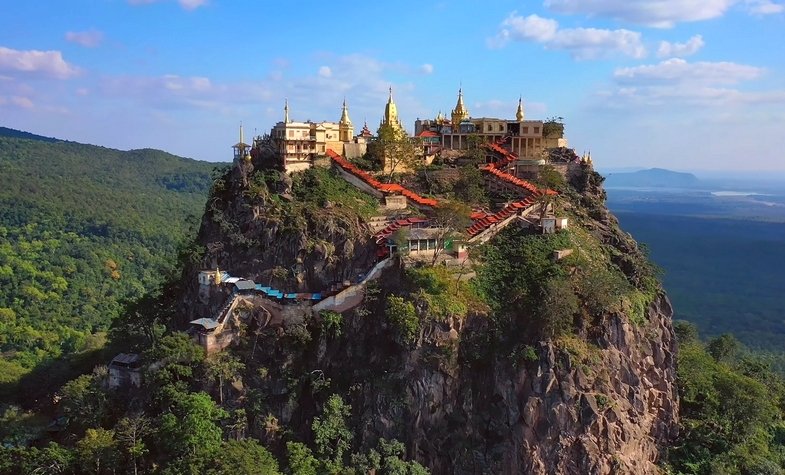(Mount Popa in Myanmar. Image source: Travel Authentic Asia)
On the morning of December 26, 2023, a transgender woman knelt in prayer in a village near Mount Popa National Park in Myanmar. She was consecrating a nat shrine as a spirit medium, hired by a local non-profit group called Mahagiri. This group, focused on environmental conservation, aims to revive abandoned nat shrines in the park to protect the lush forests and biodiversity. With the region facing the impacts of the climate crisis, the group turns to traditional beliefs in nats to address environmental challenges.
Mount Popa National Park, situated in Myanmar’s central dry zone, is a critical carbon sink and biodiversity hotspot. The region’s forests, designated as a national park in 1989, face threats due to inadequate forest law enforcement. Mahagiri’s efforts to revive nat shrines align with their strategy to protect the environment and combat climate change.
In Myanmar, the animist nat cult coexists with Buddhism, with a rich tradition of worshipping nature spirits and deities. Mahagiri’s work to revive nat shrines reflects the cultural significance of nats in Burmese society. By combining traditional beliefs with environmental conservation efforts, Mahagiri aims to provide long-term protection for the forests of Mount Popa and contribute to global climate change mitigation.

(Nat statues on Mount Popa. Image source: insideasiatours.com)
Mount Popa’s enchanted forests hold deep cultural and spiritual significance for the people of Myanmar, with beliefs in nature spirits and deities shaping their interactions with the natural world. By recognizing the importance of nats in environmental conservation, Mahagiri’s efforts to revive nat shrines offer a unique approach to addressing the climate crisis and protecting the biodiversity of Mount Popa National Park.
During a recent hike on Mount Popa, Tin Ko Min discovered a wooden nat statue under a tree. He described the statue as energetic and identified it as a Maung Yokkaso Thitpin Saung Nat. Mount Popa is home to thirty-seven spirit lords and numerous local spirits, with Min Mahagiri and the Mother Goddess of Mt. Popa being particularly revered.
Sai Nor Khay, a retired history professor, highlighted the significance of Min Mahagiri as the spiritual owner of Mount Popa. A royal order from King Bodawphaya in 1806 instructed offerings to the thirty-seven spirits and sought assistance from Min Mahagiri in capturing a white elephant.
In a lecture at Northern Illinois University, U Nu recounted a story where a dam leak in Mount Popa was only fixed after appeasing Min Mahagiri. Philosopher David Abram suggested that traditional Burmese beliefs view the world as expressive and gesturing.
While some Buddhists reject nat worship as superstition, others like U Nu believe it is compatible with Buddhism. Conservation groups in Myanmar draw inspiration from Buddhist environmental ethics, emphasizing interdependence and care for all beings.
Mahagiri’s conservation efforts are rooted in traditional Burmese nat animism, where nature is believed to be enspirited and should be respected. They have revived nat shrines in Mount Popa to protect the area, organizing awareness campaigns and ceremonies to honor the nats.
The revival of nat shrines has helped instill respect for the environment among locals and deterred interference in protected areas. Mahagiri’s efforts have focused on increasing environmental literacy and restoring abandoned nat shrines to safeguard Mount Popa’s forests. Tin Ko Min and his team are working on a plan to revive more nat shrines and organize traditional nat festivals known as nat pwe to educate younger generations about the nat cult.
They have also utilized the local community’s respect and fear for Min Mahagiri to discourage littering in the national park. A poster in the Burmese language along the road to the park warns visitors that Min Mahagiri may punish those who litter Mount Popa with plastic waste.
According to Tin Ko Min, the fear of nats’ wrath in this life is more immediate for the people of Mount Popa than the consequences in future lives through karma. He firmly believes that Min Mahagiri does punish those who disrespect the environment.
For the members of Mahagiri, the revival of nat shrines is not only about conservation but also a genuine practice of nat animism. They regularly visit the shrine of Min Mahagiri in Taung Kalat to seek protection and blessings for their endeavors.
Tin Ko Min emphasizes the importance of living in harmony with nature and viewing the forest as their ancestors did – as a living entity. He stresses the need to connect with their ancestors through nature.
Bikash Kumar Bhattacharya is a freelance journalist and researcher with work published in various reputable publications. His coverage includes regions like northeast India, Myanmar, and Timor-Leste. More of his writings can be found at https://www.bikashkbhattacharya.com/.
Source link





